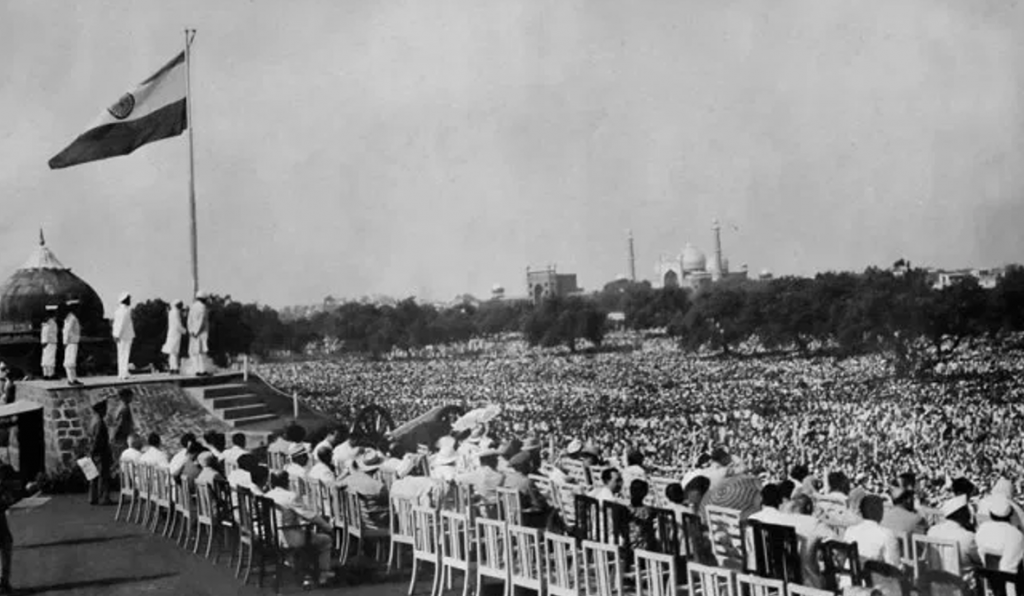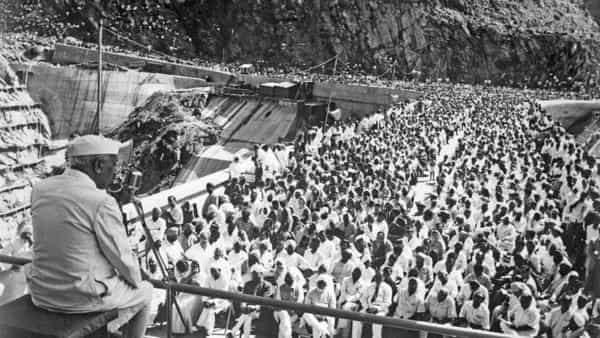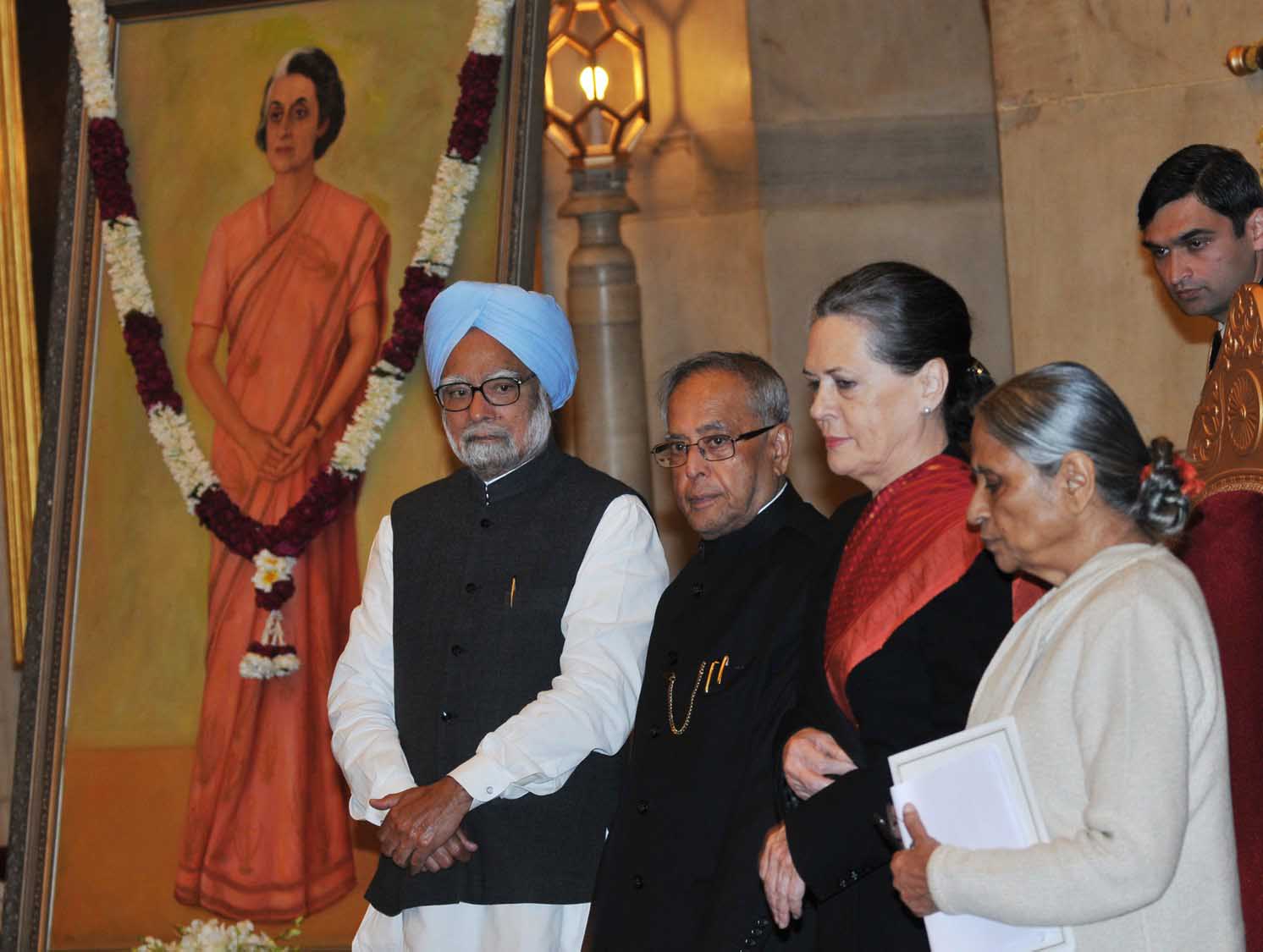By Saptasindhu Basu
Recently, India and China had a standoff in the region of East Ladakh. In fact, this standoff is still ongoing as we speak. Our Government has a habit of bringing up the past whenever they’re questioned about the present. So, let us indeed have a look at the past.
India became a Sovereign Nation on August 15, 1947. However, the events that ensued weren’t very peaceful. The India that you see today is in stark contrast to the India that existed at the time.

The first challenge that independent India faced was the Indo-Pak War of 1947. It was the first ever war fought in the world over the annexation of Kashmir. When India was about to become independent, all the princely states of the subcontinent were asked to accede to either India or Pakistan. However, there was one unique case, the case of the Princely State of Jammu & Kashmir which was being ruled by Maharaja Hari Singh at the time. They decided that neither will they accede to India nor will they accede to Pakistan. They actually wanted to forge a sovereign state of their own. Nonetheless, the masses were conflicted. The Western districts were predominantly in favour of acceding to Pakistan while the districts in the East coinciding with the Ladakh Plateau and Jammu were in favour of acceding to India. Nonetheless, the most popular political organization in J&K at the time, the National Conference under the leadership of Sheikh Abdulla, favoured India as they took a secular stand. The fate of J&K was rather uncertain until Oct 22, 1947. Armed troops of tribal militias backed by the Pakistani establishment crossed the border and started advancing towards the city of Srinagar. The Western districts readily yielded making the Maharaja lose his entire control over West Kashmir. The window of opportunity arose when the militias, instead of continuing to advance as per stipulated schedule, started plundering the Western districts after capturing them. They looted, raided and committed all forms of heinous crimes against the residents. The delay enabled Maharaja Hari Singh to make an appeal to India for military support. The then Prime Minister of India, Jawaharlal Nehru, agreed, but he put forth two conditions. Firstly, the support shall only be provided after J&K signed the Instrument of Accession, thereby acceding to India. Secondly, the accession can’t be deemed legitimate until and unless it was supported by the citizens of J&K and the support of the citizens shall be represented by the Leader of the National Conference, Sheikh Abdulla. After multiple rounds of intense negotiation, the Maharaja had to agree on both. The Instrument of Accession was signed. Sheikh Abdulla was released from detention with immediate effect and allowed to work in the state administration. Military protection was finally granted to J&K upon the approval of the Nehru Regime. But, as expected, the Pakistani Government refused to acknowledge the validity of the accession and decided to continue the use of force for establishing dominion. That’s how the first ever Indo-Pak War came to be. The war went on for one year, two months and two weeks. Mother India lost 1,104 of its bravest and most selfless fighters. 3,154 were injured. Losses on the Pakistani side totalled at approximately a whopping 6000 with 14000 injured. The conflict took a particularly dark turn when the Pakistan-backed tribal militias captured the territory of Mirpur on Nov 25, 1947. The women of Mirpur were captured and trafficked to the city of Rawalpindi to be sold off as sex slaves in brothels. About 400 women ended up committing suicide to avoid captivity that day. Today, we call it the ‘Mirpur Massacre of 1947’. Another exceptional incident observed in the war was of Col. Sher Thapa. He was stationed in the region of Skardu. They were relentlessly attacked by the Pakistani militants, but Col. Thapa held his ground, leading a mere 250 soldiers under his command for six whole months with no reinforcements. He ultimately had to yield after almost a year-long ruthless tussle. But, his valour resonates in the Indian Armed Forces to this day. The ultimate outcome of the war was a series of heated negotiations between the two Governments. A ceasefire was agreed upon rendering India a decisive victory with two-thirds of Kashmir being proudly embraced into its federal union. The remaining one-third was given to Pakistan. To this day, Pakistan refers to that one-third as ‘Azad Kashmir’ to propagate a false sense of pride in the form of a consolation prize. However, the world continues to refer to it as Pakistan-occupied Kashmir, refusing to acknowledge its legitimacy. India’s geographical area was 29,49,353 sq Km before the war. After the war, it became 30,85,431 sq Km with an addition of 1,36,078 sq Km.
It’s interesting to take note of the fact that as India was resolving the issue regarding annexation of J&K, it was also resolving the issue regarding the annexation of the Princely State of Junagadh. The erstwhile Nawab of Junagadh, Muhammad Khanji III, favoured acceding to Pakistan rather than India, but that was the polar opposite of what the citizens of Junagadh preferred. However, without taking the public sentiment into consideration, the Nawab simply bulldozed his way through to sign the Instrument of Accession to Pakistan. As this was completely against the wishes of the people of Junagadh, the Nehru Government decided to oppose this. Their argument was simple, which dominion the Princely State of Junagadh should accede to is a decision that only the people of Junagadh were entitled to make. As a mark of dissent, the Nehru Government imposed a national prohibition on conducting any form of trade with Junagadh. This practically demolished the economy of Junagadh and the masses were absolutely outraged. The economic distress triggered a massive outcry in the State and the Nawab, becoming paranoid, just fled to Karachi with his family. In the absence of their Nawab, the State was left devoid of any leadership. So, the people of Junagadh, with the support of the Nehru Government, were able to establish a temporary Government dubbed as ‘Aarzi Hukumat’. In fact, this ‘Hukumat’ was successfully formed to the credit of a personal initiative taken by none other than Mahatma Gandhi’s own nephew, Samaldas Gandhi. Soon enough, the temporarily established administration of the Princely State of Junagadh signed the Instrument of Accession to India and declared the territory of Junagadh to be on Indian soil. However, this wasn’t enough for Nehru. On Feb 20, 1948, he held true to his commitment. A plebiscite was held in Junagadh for the citizens to cast their votes and themselves take the decision of whether to accede to India or to Pakistan through a democratic mandate. The result was an outstanding 99.95% of the votes being casted in favour of India against Pakistan. With no further delay, the mandate was accepted by the Government of India. As a result, India’s geographical area increased from 30,85,431 sq Km to 30,94,074 sq Km with an addition of 8,643 sq Km.

Next was the Princely State of Hyderabad. The Nizam of Hyderabad opted for sovereignty and decided to accede to neither India nor Pakistan. On top of it, the Nizam had forged his own militia with manpower supplied by the Muslim aristocracy of the State. The militia referred to itself as the ‘Razakars’. However, the problem arose when there took place a communist uprising in the State. The clashes between the communist rebels and the Razakars were becoming increasingly violent as well as more and more brutal every day, so much so that it started exerting quite an impact on the law & order situation of the adjoining areas of the State which coincided with Indian territory. As the situation was on the verge of spiralling completely out of control and deteriorating into a full-fledged civil war, PM Nehru and the then Home Minister, Vallabhbhai Patel, took the joint initiative to arrive at a feasible solution. Operation Polo was conducted and the Indian Armed Forces directly intervened upon the directives of the Government of India. After an intense military conflict from Sep 13 to Sep 18, 1948, the Nizam surrendered and the Instrument of Accession to India was signed. This further increased the geographical area of India from 30,94,074 sq Km to 33,09,413 sq Km, adding a staggering 2,15,339 sq Km.
Then, it was the turn of Pondicherry. It originally used to be a French colony within the Indian subcontinent. But, a series of meetings were held between the France-backed administration of Pondicherry and the Nehru Government. Once they were able to persuade them, a joint statement was made by both sides on Oct 13, 1954. It declared that the formal proceedings for the merger of Pondicherry with the Indian Union shall begin soon. Just five days later, on Oct 18, 1954, a referendum was held for the members of the representative assembly and the municipal counsellors of Pondicherry to cast their votes and decide whether to accede to India or remain under French rule. Out of 178 voters, 170 voted in favour of India. So, three days later, an agreement was signed by the Nehru Government and the French authorities to approve the merger. It was in 1962 that France declared that all territories held by France in the Indian subcontinent shall merge with the Indian Union. That is how Pondicherry, Laraikal, Mahe and Yanam together formed the Union Territory of Puducherry thereby further expanding Indian territory from 33,09,413 sq Km to 33,09,896 sq Km with an additional 483 sq Km.
Then, India shifted its attention to Portugal. The Portuguese colonies in the Indian subcontinent were Goa, Daman & Diu and Dadra & Nagar Haveli. Internal conflicts actually brewed for many years. Finally, in 1961, the colonies witnessed a massive rebellion triggered by huge economic distress. Various socio-political organizations started protesting to speak up against the sheer administrative apathy in the State. However, the Portuguese authorities ended up completely mismanaging the situation. The brutality peaked on Aug 15, 1955 when 3,000 to 5,000 unarmed pro-India activists attempted to organize a non-violent protest in Goa, but they were assaulted with armed Portuguese policemen. This resulted in the loss of at least 30 innocent lives. Again, on Nov 24, 1961, a passenger boat travelling from the port of Kochi to the erstwhile Portuguese-held island of Anjidiv was shot down by Portuguese troops leading to the brutal death of a passenger and a severe injury to the chief engineer. Incidents like these were the reason for public sentiment being radically against Portuguese occupation. This ultimately culminated into multiple such rebel groups to join hands and orchestrate a full-fledged freedom movement across all the Portuguese colonies. Finally, The Portuguese gave up and agreed to surrender all its colonies in the region to the Indian Union. Dadra & Nagar Haveli were annexed on Aug 19, 1961. Goa and Daman & Diu were annexed on Dec 19, 1961. These annexations further boosted India’s territorial coverage from 33,09,896 sq Km to 33,14,197 sq Km by an addition of 4,301 sq Km.
The next major territorial dispute faced by India was the Indo-China War in 1962. The conflict went on for a whole month. The conflict actually arose due to a dispute between India and China over the area of Aksai Chin, certain parts of Arunachal and the North-East Frontier Tracts (NEFT). India claimed Aksai Chin as a part of Kashmir, but China claimed it as a part of its Xinjiang Province. The war broke out when the Chinese started constructing roads in Aksai Chin. In the course of the war, China had an army of around 80,000 while the Indian Army was of 22,000. Suffice to say, China didn’t think twice before taking full advantage of their availability of man power. After all, to this day, China remains the country with the highest population in the whole world. India attempted at taking assistance from the United States, but they refused. In the aftermath of the war, the Chinese consolidated their control over Aksai Chin. It had a geographical coverage of 37,244 sq Km. This continues to be interpreted as India’s defeat and China’s victory. However, the world conveniently forgets to acknowledge that in spite of having an army which was less than one-third of that of her rival, Mother India persevered and consolidated its authority over the NEFA region, a region with a geographical coverage of approximately 83,000 sq Km. After the war came to an end, Indian authorities were able to understand exactly where the Indian military was lagging behind. The major positive outcome was that immediately after the war, an aggressive modernisation drive was conducted in the Indian Armed Forces with the purchase of new military equipment, new gear, new technology, new weapons as well as the introduction of new forms of military training.
The Indo-China War of 1962 was the final episode in India’s list of major territorial disputes during the era of Jawaharlal Nehru. When India first got its independence with Jawaharlal Nehru as its first prime Minister, the total area of the country was 29,49,353 sq Km. By the time Nehru’s tenure came to an end, it was 32,76,953 sq Km with a net increase of 3,27,600 sq Km.
Up next is none other than the Iron Lady of India, Indira Gandhi. Before its annexation to India, Sikkim used to be a monarchy. However, the public sentiment in Sikkim was largely against the monarchy for a variety of reasons including oppressive rule and economic distress. So, in the year of 1975, the Prime Minister of Sikkim made an appeal to allow the State of Sikkim to pledge its allegiance to the Republic of India. As it turns out, the apple doesn’t fall far from the tree. Prime Minister Indira Gandhi made it clear that the citizens of Sikkim were the only ones entitled to take the decision of whether to merge the State with India. So, a referendum was held in the region. As a result, a staggering 97.5% of the votes were casted in favour of acceding to India. Following this historical mandate, the agreement was finally signed, the monarchy was abolished and Sikkim was declared an integral part of the Republic of India. Because of this merger, India’s territory further expanded from 32,76,953 sq Km to 32,84,049 sq Km with an addition of 7,096 sq Km.
After this, came the Bangladesh Liberation War of 1971. During the time of the Partition, East Bengal was made East Pakistan following Jinnah’s argument of East Bengal being a predominantly Muslim region. West Bengal was acknowledged as Indian territory for being predominantly Hindu. Jinnah intended to unite Pakistan on the grounds of religion. Unfortunately, Pakistani society was plagued with racial discrimination specifically targeting Shias, Ahmadis and especially Bengalis. The final nail in the coffin was when the Pakistani establishment attempted to forcefully impose Urdu on East Pakistan. This was interpreted as a personal attack on Bengali culture which was built on the very foundation of the Bengali language. It was as if the Pakistani establishment was trying to take their identity away from them and this triggered a massive uprising across East Pakistan. The entire Bengali community got united under the banner of a rebel organization called ‘Mukti Bahini’ or the ‘Liberation Army’ against Pakistan. However, the Pakistani military was made to intervene which led to the loss of thousands and thousands of innocent Bengali lives. Looking at the criticality of the situation, the Government of India under the directions of Indira Gandhi decided to back the Bengali community by providing military assistance. A huge military conflict ensued, this time with sufficient firepower on both sides. 2,50,00 Indian soldiers and 1,75,000 freedom fighters of Mukti Bahini laid down their lives. Losses on the Pakistani side were recorded as close to 4,00,000 with 3,65,000 soldiers and 25,000 militants. The end result was the liberation of East Pakistan. That’s how East Pakistan became the People’s Republic of Bangladesh on Dec 16, 1971. Pakistan lost 1,48,460 sq Km of its territory. To this day, Bangladesh remains one of India’s most valued strategic partners in the South Asian region.
On Apr 13, 1984, Operation Meghdoot was conducted to consolidate India’s claim over the Siachen Glacier. In the Karachi Agreement of 1949, it wasn’t clearly specified whether Siachen was to be acknowledged as Indian territory or Pakistani territory. So, both nations continued staking claim over it making it a disputed area. The conflict broke out when Pakistani Government started approving tourist expeditions to Siachen. It wasn’t authorized to do so as this was a clear violation of the mutual understanding. As a result, Operation Meghdoot was conducted on Apr 13, 1984 by the Indian Army under the directives of Prime minister Indira Gandhi. The outcome of Operation Meghdoot was the territorial coverage of the Indian Union increasing from 32,84,049 sq km to 32,86,602 sq Km with an addition of 2,553 sq Km.

The next major territorial dispute faced by India was the Khalistani Separatist Movement under the leadership of Jarnail Singh Bhindranwale. In the beginning, it was actually a campaign that a regionally active political party called the Akali Dal was conducting to guarantee autonomy to the State of Punjab and declare Chandigarh as part of the State by revoking its status as a Union Territory. Then, after Bhindranwale was brought onboard, he hijacked the entire movement. It became an extremist insurgency that started pushing for the cessation of Punjab from India under the pretext of religion. Bhindranwale was a religious preacher in Punjab who demanded the establishment of a separate Sikh nation in the Indian sub-continent, an initiative that the Pakistani authorities were more than willing to back. However, Indira Gandhi’s response to this demand was clear, not even a chunk of Indian soil shall be given up. In the course of the Khalistani Insurgency, between Aug 4, 1982 and Jun 3, 1984, more than 1,200 violent incidents took place resulting in the death of 410 people while 1180 got injured. In the year 1984 alone, 775 violent incidents took place taking the lives of 298 and injuring 525. Bombings, assassinations and even hijackings, the militants left no stone unturned. Throughout this whole time, Bhindranwale made full use of his influence in the religious circles of the Sikh Community in Punjab and kept collaborating with a regional political party by the name of Akali Dal to dub the extremist insurgency as a political campaign in the eyes of the media. Every time any militant would get injured or pursued by the police, they would simply take shelter in gurudwaras. This was because Indian Administration refused to allow the police to step inside religious sites to preserve the sanctity and not hurt religious sentiments. Multiple rounds of negotiation were conducted between the Government and representatives of the Akali Dal to arrive at a peaceful resolution. Indira Gandhi herself personally met with the representatives not just once, but thrice. However, no progress was made. Ministers who were present in the meetings had been quoted as saying that it almost seemed as if the Akali Dal did not have any control over the movement whatsoever and was only being used as a front to do the bidding of the militants. The Golden Temple, the most sacred site for the Sikh Community, was transformed by Bhindranwale and his followers into the administrative base of their militant activities. The entire Temple was being guarded by armed extremists and the law & order machinery of the State of Punjab was practically under Bhindranwale’s control. Repeated requests were made to Bhindranwale to at least allow the innocent worshippers to vacate the temple, but the response was an outright rejection. It seemed like a lost battle, especially after the Pakistani Authorities started supporting the insurgency through the ISI. On Jun 1, 1984, Major General Kuldeep Singh Brar was entrusted with the responsibility of conducting a military operation which we today refer to as ‘Operation Blue Star’. Right before kickstarting the operation, General Brar made an announcement that the operation shall be conducted against Sikh militancy and not Sikh religion. He promised that if there were anybody in the task force who had any second thoughts about being a part of the mission, they were free to back out and it would not be held against them. Not a single soldier backed out. With the combined total of the extremists huddled up in the Golden Temple, the Indian soldiers assigned in the Operation and the civilians who got caught in the crossfire, the death toll rose to approximately 500. It was a tragedy, but according to General Brar, it was the only option left. Nonetheless, the helplessness of the situation wasn’t considered acceptable as a justification. The religious sentiments of the Sikh Community were deeply hurt and to this day, Indira Gandhi’s legacy continues to bear ‘Operation Blue Star’ as a dark stain. In the aftermath of the tragedy, on Oct 31, 1984, Indira Gandhi was assassinated. The assassins were her own bodyguards, two Sikh gentlemen, Satwant Singh and Beant Singh. 36 bullets were shot at her, 29 passed through and 7 got stuck inside. India lost its Iron Lady.
The next big challenge that India faced over its territory was the Kargil War that happened from May 3, 1999 to Jul 26, 1999 during the Prime Ministership of Atal Behari Vajpayee. On Feb, 1999, The Indian Government and the Pakistani Government signed the Lahore Declaration making a promise to resolve the Kashmir issue peacefully through dialogue. However, throughout the Winter season of the year 1998-99, the Pakistani Armed Forces were covertly training and sending their soldiers across the border into Indian territory under the disguise of members of the revered terrorist organisation, Mujahideen. The infiltration was dubbed as ‘Operation Badr’. Some suggest that it was an attempt made by Pakistani Military to avenge Operation Meghdoot. In the course of the War, 527 Indian soldiers had to sacrifice their lives, 1363 soldiers were injured, one fighter jet and one helicopter were shot down, one fighter jet crashed and Captain Kambampati Nachiketa was captured and incarcerated. Losses on the Pakistani side totalled at 700. India was able to regain control of the Kargil Peak, but had to lose a strategically crucial region, Point 5353. Today, Point 5353 continues to stand tall as a mountain peak on the Line of Control along the India-Pakistan Border. The number denotes the height of the peak above sea level in metres.
Today, once again, we are faced with a challenge. China has again attempted to illegally occupy Indian territory by infiltrating East Ladakh. A major blunder was to be naïve enough to send Indian soldiers to patrol the disputed region unarmed on Jun 15. 20 of them were brutally killed. According to families and eye witnesses, one of the soldiers died due to his throat being slit and most of the others were pushed off the edge into the freezing cold water of the Galwan River. At a height of 14,000 ft, in spite of not being allowed to carry fire arms, Mother India’s brave sons held their ground for six gruelling hours. Three died due to their arteries being ruptured and two sustained severe injuries in the head inflicted by some pointed object, possibly a sharp blade. All the soldiers belonged to the 16th Bihar Regiment. It has been the biggest armed conflict between India and China in the last sixty years. Nonetheless, political analysts argue that the biggest diplomatic blunder made by the Modi Government was Prime Minister Modi’s announcement in the all-party meeting on Jun 19, 2020 where he announced that no external power has entered Indian territory illegally. It was supposed to be an attempt at keeping the public in the dark so that they do not be paranoid. But, it gave the Chinese Administration an opportunity to claim his statement as an admission of the fact that the Galwan Valley of East Ladakh that the Chinese Army infiltrated was Chinese territory, not Indian. The announcement was endorsed and spread by the Chinese media across China as well as every other nation where their programs are broadcasted. So far, even after giving multiple assurances, the Chinese have not been showing any sign of backing off.
Will the Modi Government be able to hold its ground and live up to the precedent set by the ones who prevailed before them? Well, if they do not, then the burden of humiliation will have to be borne by the whole nation for generations to come. We as concerned citizens can only pray that Mother India perseveres.
Disclaimer: The opinions expressed within this article are the personal opinions of the author. AlignIndia do not take any responsibility for the content of the article.
Saptasindhu Basu is a Researcher, a Student and freelance writer. He tweets with @saptasindhubasu


